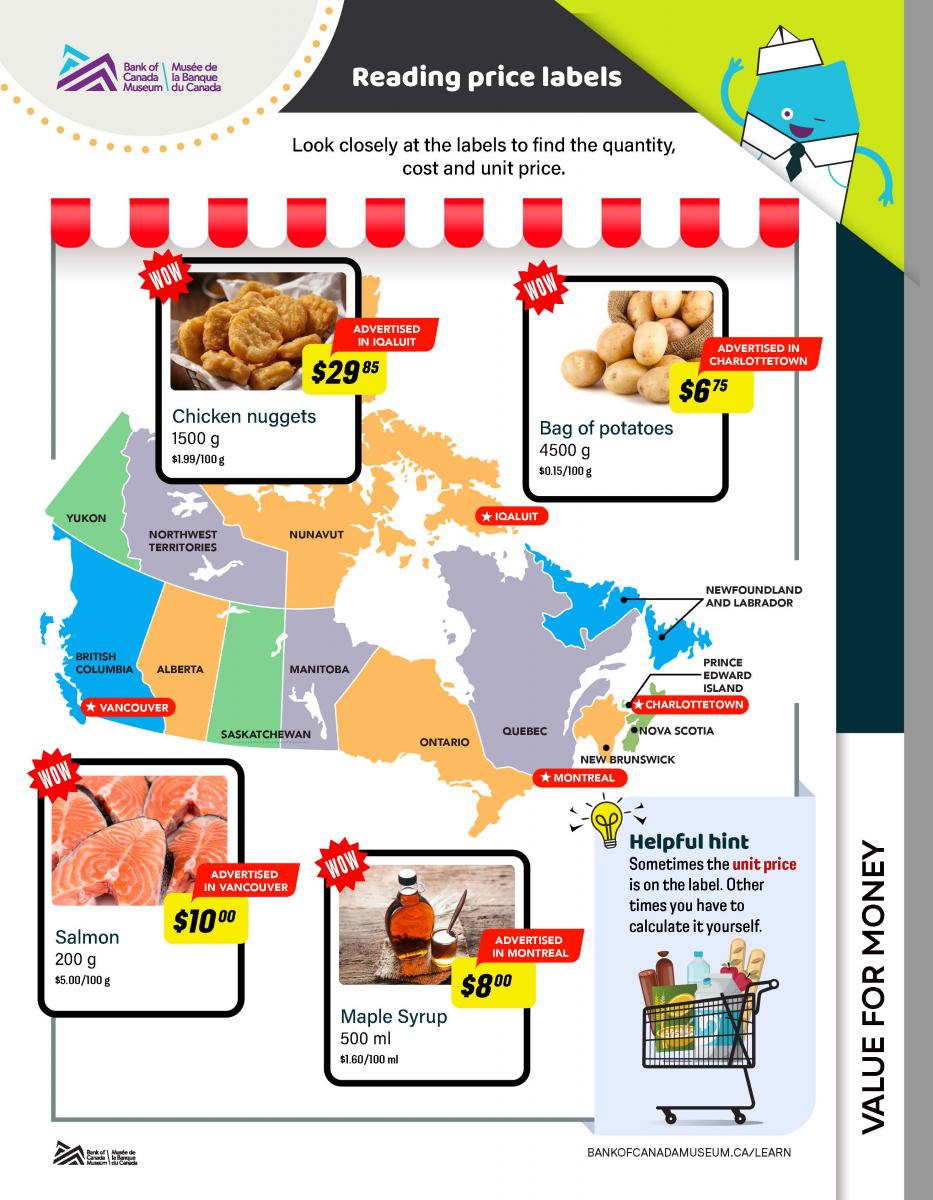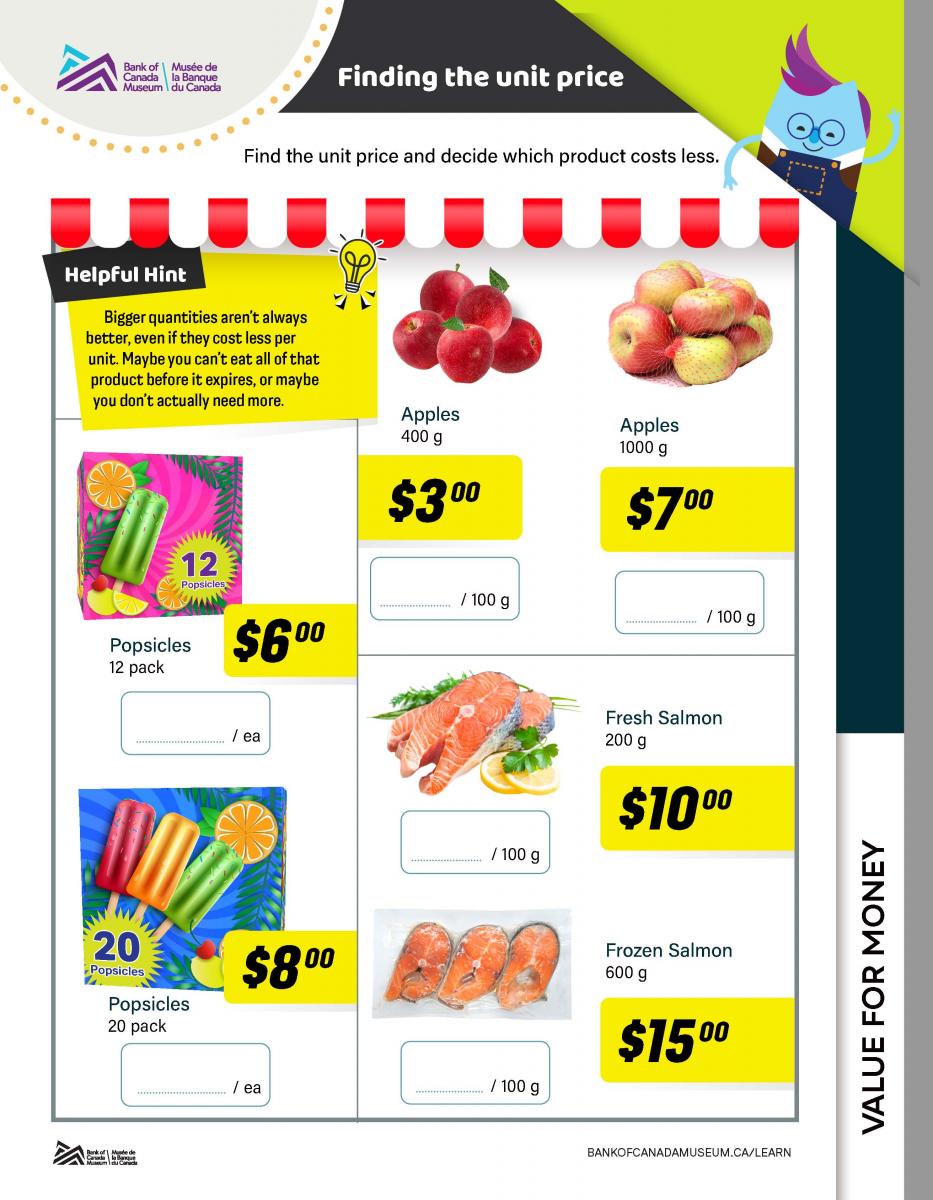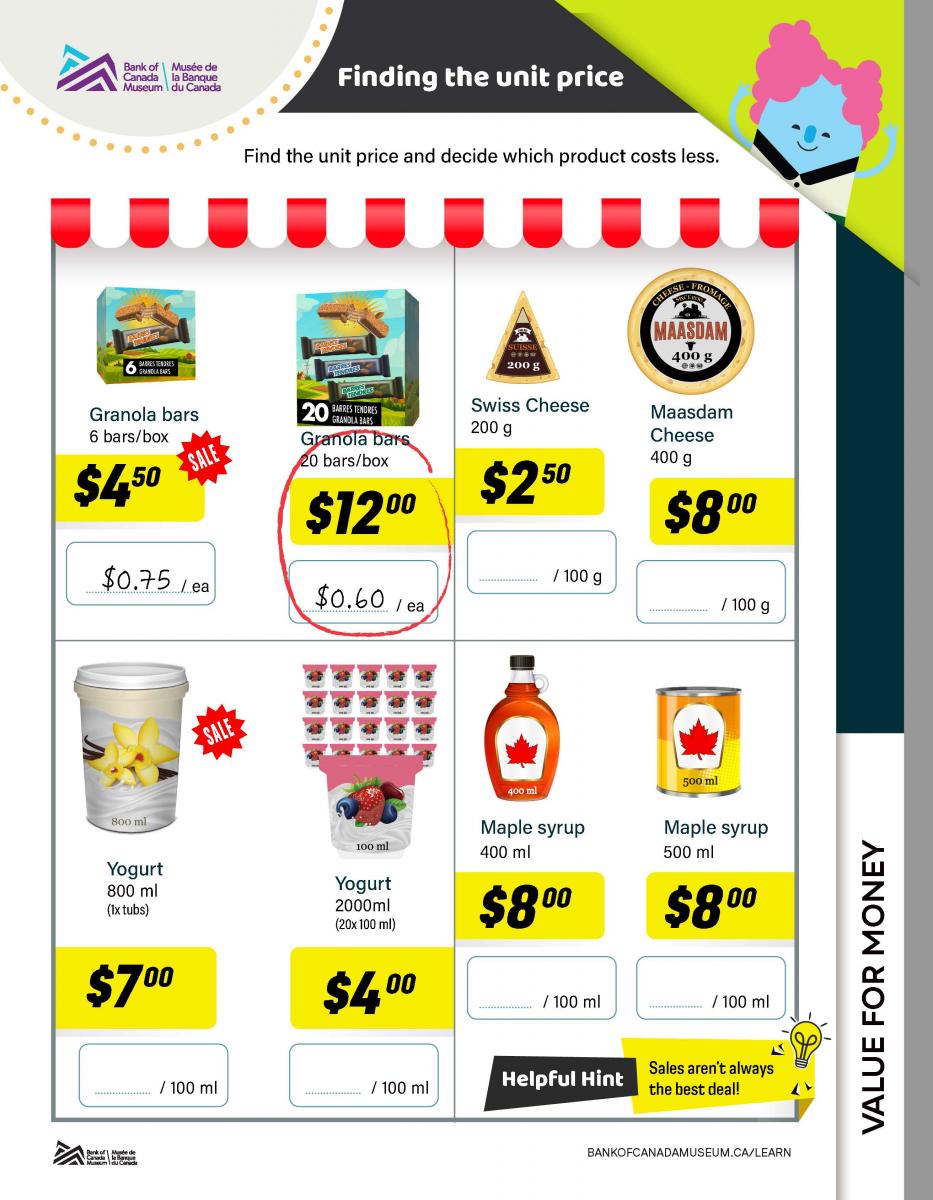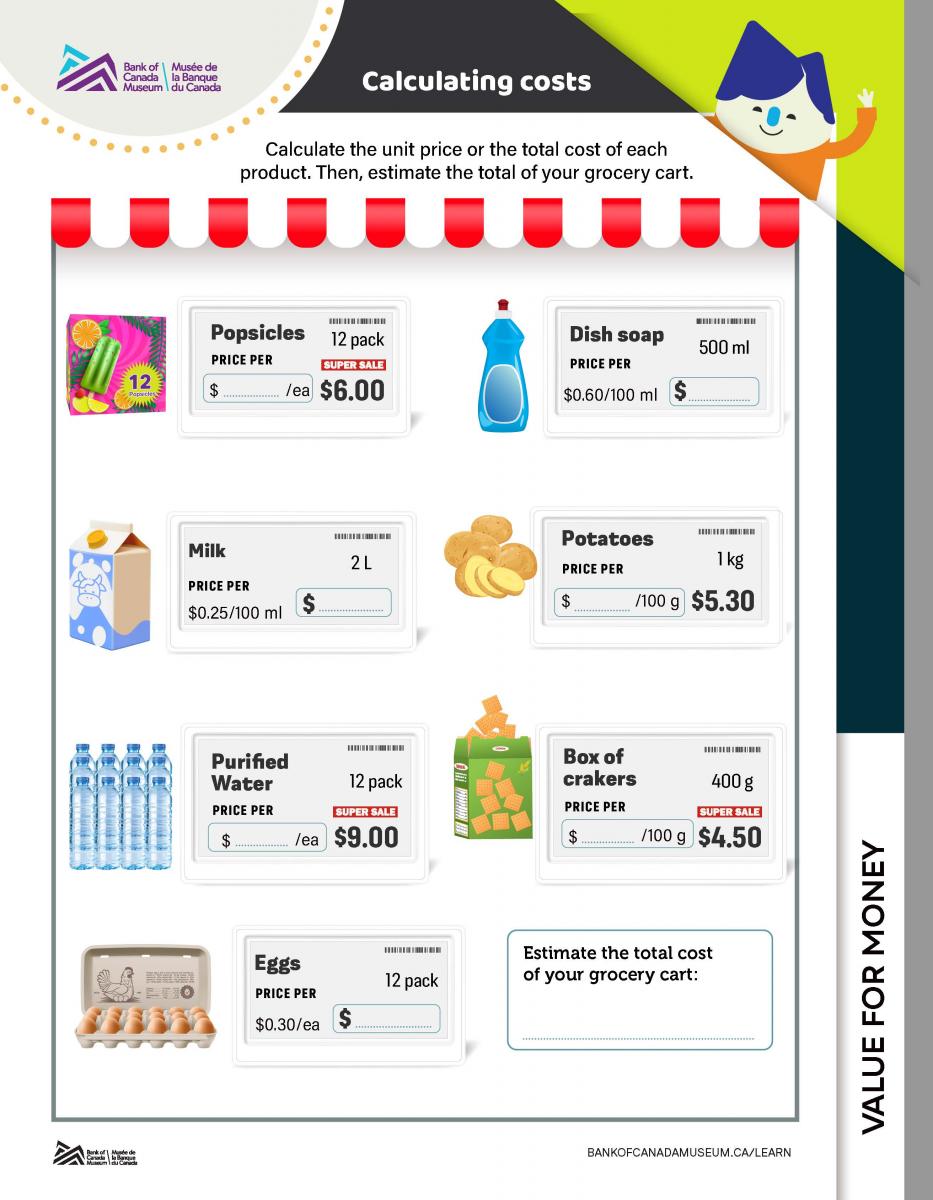
Calculate unit prices and compare value for money. Use real-life shopping scenarios to determine if something is a real deal.
Overview
Big idea
We use division and multiplication in daily life when we find the unit price of a product and determine the best value for money.
Total time
60 to 75 minutes
Grade level
Grade 4; Elementary Cycle 2
Subject areas
Math
- estimate the total cost of transactions involving multiple items
- describe ways of determining whether something is reasonably priced
- solve a situational problem that involves more than one type of information
- solve problems using multiplication and division, including problems using money and different units of measurement
- represent money using decimals and solve problems, including money problems, which involve decimals
Financial literacy
- develop knowledge and skills to determine whether something is a good value
- make simple financial decisions that involve spending
- make responsible choices for you and your family that are supported by knowledge and skills
Learning objectives
Students will:
- use division to determine the unit price of a grocery store product
- use multiplication to determine the total cost of a product from the unit price
- compare the unit price of a product and choose the best value for money when shopping
Materials
Classroom supplies and technology
- pencils
- printer
- scissors
- white board (or chart paper) and markers
- optional: smartboard or projector
- optional: calculators
Worksheets
- Download the activity and answer sheets.
- Print worksheets and graphics for each student:
- Activity 1: “Reading price labels” (one copy for every four students, or show on a screen)
- Activity 2: “Finding the unit price” (one copy for each student or pair of students), “Calculating the unit price” (one copy for each student or pair of students)
Activity 1: Reading price labels
In this activity, students will learn how to read labels in grocery stores and what unit price means.
Time
20 minutes
1.1 Opening discussion
Discuss with your students what they notice about prices when they visit a store—especially a grocery store.
Ask the following questions to get them thinking critically about what they see.
- How do you know how much something costs?
- What does it mean to get a good deal? How do we find the best deal?
- What does it mean for something to be on sale? Is a sale always the best deal?
- Why is it important to be aware of how much money you’re spending?
1.2 Worksheet activity: Reading price labels
Divide the students into groups of four. Hand out a copy of “Reading price labels” to each group. Alternatively, display it on the projector for the whole class.
Demonstrate how to read a label at a grocery store to determine the unit price. The illustration has several examples from different parts of Canada.
Explain the following terms. You may want to write them on the board or a piece of chart paper.
- Unit price is the cost of one item or one standard unit of measurement of an item. Different grocery items are divided in different units. For example, because eggs are grouped and sold by size, their unit price is the cost for each egg. In contrast, apples are different sizes. They are usually priced by weight, such as the cost per 100 grams. A liquid like milk would be priced per 100 millilitres.
- Quantity is the amount of a product in a package. This can be measured in grams or millilitres, or by the number of items.
- Total cost is the amount you’ll be charged for a product. In some cases, taxes are charged on top of this amount. In Canada, taxes aren’t charged on basic groceries, but can be charged on candy, soft drinks, chips and some other groceries.
Have the students look at the [other/remaining] examples on the sheet. Ask the following questions, and help them through the answers by showing the math on the board.
- If you know the quantity and the total cost, how would you calculate the unit price?
- Divide the total cost by the quantity.
- For the chicken fingers, you can divide the total cost by the number of chicken fingers in the box to find the price for each.
- For the potatoes and salmon, you are looking for the cost of 100 grams—not 1 gram—so you’ll first need to divide the quantity by 100. For example, to calculate the price for 100 grams of salmon,
- Divide the total cost by the quantity.
- If you know the quantity and the unit price, how would you calculate the total cost?
- Multiply the unit price by the quantity. For example, if the potatoes are listed for $2 each and you need three potatoes, you would multiply the unit price ($2) by the quantity (3) to find the total cost: $6.
- When would you need to use the unit price at the store?
- when you’re comparing two different products like apples and oranges, two different brands of the same product, or different sized packaging of the same brand to find the best deal
- when you’re determining whether a sale is a good deal
Products, especially groceries, don’t cost the same in all parts of the country. Many factors contribute to these differences such as:
- In British Columbia, salmon might be cheaper than in other parts of Canada because it’s farmed nearby.
- In Prince Edward Island, potatoes may be cheaper because the province grows one-quarter of all the potatoes grown in Canada.
- In the North, groceries are more expensive because they have to be shipped from far away, sometimes by boat or plane. In Nunavut and other northern communities, frozen chicken can cost three or four times as much as in a big city in the south.
Activity 2: Finding the unit price
In this activity, students will learn how to find and calculate a unit price from a total cost, and the reverse, the total cost from the unit price.
Time
35 to 45 minutes
2.1 Worksheet activity: Finding the unit price
Have the students work individually or form pairs. Hand out the “Finding the unit price” worksheets.
Do the first question together so students can practice finding the unit price on a price tag and choosing which product is the best deal.
Then have your students or pairs complete the next questions. Note that in the last question, the unit price is blank and students will have to calculate it themselves.
Once students have completed both pages, display the "Finding the unit price" answer key on a projector or smartboard. Have the students correct their answers together as a class."
Take a moment to review the final question (#4) together.
2.2 Worksheet activity: Calculating the unit price
Hand out a copy of the “Calculating the unit price” worksheet to each student or pair. Students will use division or multiplication to find the missing amounts. Do the first question together, then allow students or pairs to finish the worksheet on their own.
When the students have completed all the answers, they should use mental math to add the total cost of each product and find/calculate the overall cost of their groceries.
Once students have completed the worksheet, display the "Calculating the unit price" answer key on a projector or smartboard. Have the students correct their answers together as a class.
2.3 Discussion
Discuss the topics of price and preferences with students:
- Are products on sale always the best deal?
- Sometimes a sale sticker doesn’t make it the best deal. You can use or calculate the unit price to compare brands or quantities and find out for sure.
- What other factors might influence you when you’re shopping? Some examples:
- You might have a favourite brand that you want to buy because you prefer the taste or the ingredients.
- Your decision might also be influenced by what is best for the environment. Think about the yogurt on the "Finding the unit price" worksheet. The individual tubs might be a better deal, and they are easier to bring to school. But they create more waste.
- Maybe you can’t eat 30 eggs before they go bad, even if they are a better deal than buying 12 eggs. This creates food waste, which isn’t good for the environment or your budget. But 30 boxes of pasta will probably last long enough for you to use them all!
Conclusion
Time
5 to 10 minutes
Tell your students that today they learned two skills that will help them be smart consumers. Learning how to choose a product and understand what things cost helps us be smarter with our money. Thinking critically to make informed decisions about how you use your money can help you save and plan for your financial future. This is important for people of all ages.
Key takeaways
- Unit price helps you compare different products and decide if a product is a good value. This is important while shopping to make sure you are spending your money wisely.
- You can calculate a product’s unit price by dividing the total price by the quantity.
- You should look at every factor, including prices and preferences, when you decide what to buy.
Extensions
- Practise finding and calculating unit price and estimating total cost using print or online flyers from local grocery stores.
- To deepen students’ understanding of price differences across Canada, use online flyers to compare prices in your city with those in a city in a different province or territory, especially a city or town in a remote location.
- Introduce the economic concepts of consumers, producers, goods, services and trade with our lesson plan “Trade Rules”—a fun, interactive game that uses cards.
- Learn about making decisions about what to buy with our activity “Needs or Wants? That is the question!”
- Expand on decision making while grocery shopping with our activity “The economics of suppertime.” This also makes a great take-home activity!




